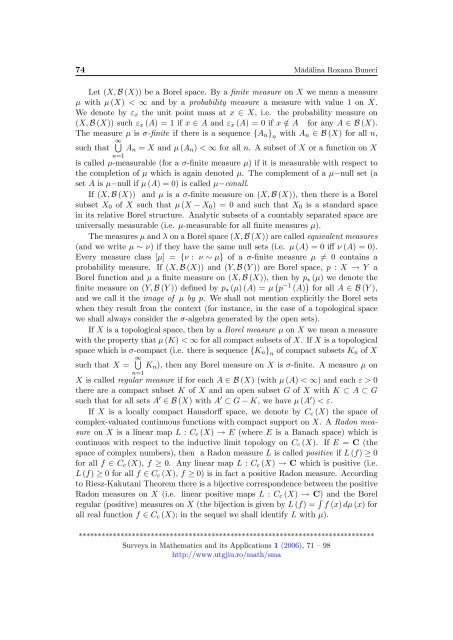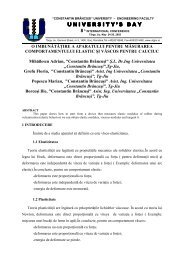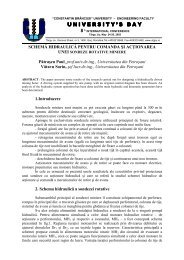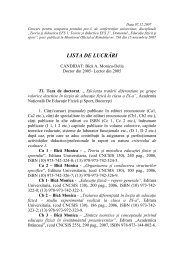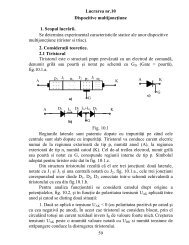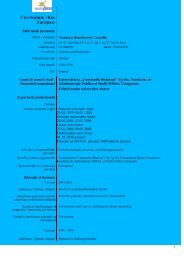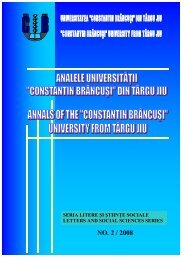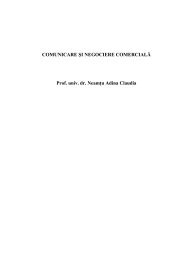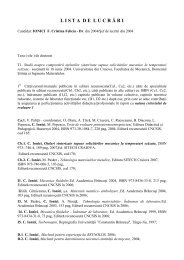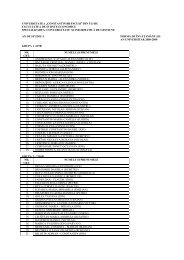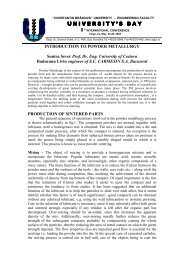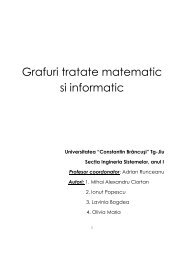GROUPOID C""ALGEBRAS 1 Introduction 2 Definitions and notation
GROUPOID C""ALGEBRAS 1 Introduction 2 Definitions and notation
GROUPOID C""ALGEBRAS 1 Introduction 2 Definitions and notation
You also want an ePaper? Increase the reach of your titles
YUMPU automatically turns print PDFs into web optimized ePapers that Google loves.
74 M¼ad¼alina Roxana BuneciLet (X; B (X)) be a Borel space. By a …nite measure on X we mean a measure with (X) < 1 <strong>and</strong> by a probability measure a measure with value 1 on X.We denote by " x the unit point mass at x 2 X, i.e. the probability measure on(X; B (X)) such " x (A) = 1 if x 2 A <strong>and</strong> " x (A) = 0 if x =2 A for any A 2 B (X).The measure is -…nite if there is a sequence fA n g nwith A n 2 B (X) for all n,Ssuch that 1 A n = X <strong>and</strong> (A n ) < 1 for all n. A subset of X or a function on Xn=1is called -measurable (for a -…nite measure ) if it is measurable with respect tothe completion of which is again denoted . The complement of a null set (aset A is null if (A) = 0) is called conull.If (X; B (X)) <strong>and</strong> is a -…nite measure on (X; B (X)), then there is a Borelsubset X 0 of X such that (X X 0 ) = 0 <strong>and</strong> such that X 0 is a st<strong>and</strong>ard spacein its relative Borel structure. Analytic subsets of a countably separated space areuniversally measurable (i.e. -measurable for all …nite measures ).The measures <strong>and</strong> on a Borel space (X; B (X)) are called equivalent measures(<strong>and</strong> we write ) if they have the same null sets (i.e. (A) = 0 i¤ (A) = 0).Every measure class [] = f : g of a -…nite measure 6= 0 contains aprobability measure. If (X; B (X)) <strong>and</strong> (Y; B (Y )) are Borel space, p : X ! Y aBorel function <strong>and</strong> a …nite measure on (X; B (X)), then by p () we denote the…nite measure on (Y; B (Y )) de…ned by p () (A) = p 1 (A) for all A 2 B (Y ),<strong>and</strong> we call it the image of by p. We shall not mention explicitly the Borel setswhen they result from the context (for instance, in the case of a topological spacewe shall always consider the -algebra generated by the open sets).If X is a topological space, then by a Borel measure on X we mean a measurewith the property that (K) < 1 for all compact subsets of X. If X is a topologicalspace which is -compact (i.e. there is sequence fK n g nof compact subsets K n of XSsuch that X = 1 K n ), then any Borel measure on X is -…nite. A measure onn=1X is called regular measure if for each A 2 B (X) (with (A) < 1) <strong>and</strong> each " > 0there are a compact subset K of X <strong>and</strong> an open subset G of X with K A Gsuch that for all sets A 0 2 B (X) with A 0 G K, we have (A 0 ) < ".If X is a locally compact Hausdor¤ space, we denote by C c (X) the space ofcomplex-valuated continuous functions with compact support on X. A Radon measureon X is a linear map L : C c (X) ! E (where E is a Banach space) which iscontinuos with respect to the inductive limit topology on C c (X). If E = C (thespace of complex numbers), then a Radon measure L is called positive if L (f) 0for all f 2 C c (X), f 0. Any linear map L : C c (X) ! C which is positive (i.e.L (f) 0 for all f 2 C c (X), f 0) is in fact a positive Radon measure. Accordingto Riesz-Kakutani Theorem there is a bijective correspondence between the positiveRadon measures on X (i.e. linear positive maps L : C c (X) ! C) <strong>and</strong> the Borelregular (positive) measures on X (the bijection is given by L (f) = R f (x) d (x) forall real function f 2 C c (X); in the sequel we shall identify L with ).******************************************************************************Surveys in Mathematics <strong>and</strong> its Applications 1 (2006), 71 –98http://www.utgjiu.ro/math/sma


